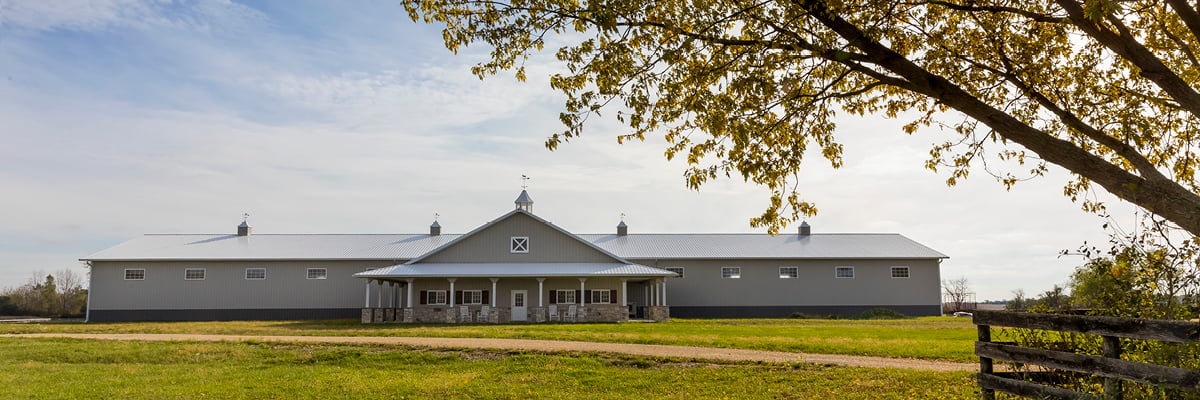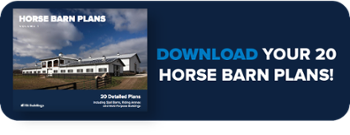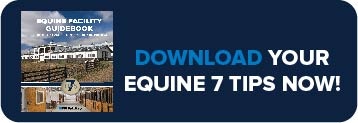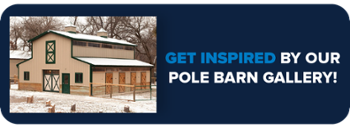Posts | Building Tips | Horse Barns | Riding Arenas
8 Design Tips to Consider When Building a Horse Barn
Cori grew up on her family's small grain and livestock operation in Northwest Indiana. In 2018, she graduated Summa Cum Laude with a Bachelor's degree in Business Administration & Marketing from Marian University Indianapolis. Having shown beef cattle for 12 years at the county, state, and national levels, Cori chose to pursue a career in agriculture. Today, she serves as the Marketing Content Creator on the FBi team. In her free time, Cori enjoys spending time with family and friends, watching sports, listening to live music, and traveling.
As an owner, you’ve considered building a top-notch pole barn for your horses. These animals are your favorite pastime (or livelihood), so why not invest in a new structure?
You already have the land set aside. You’ve been consciously saving your money. So, there’s half the battle.
Now that you’ve pulled the trigger, you’re tasked with designing a floor plan for your equine facility.
Deciphering between your needs and wants and determining how those will affect your budget can be exhausting. Just when you think you have it all figured out, you start to second guess yourself on building size, features, materials, etc. Grrr!
Don’t give up just yet. Sometimes you need a push in the right direction.
In this article, we detail eight design tips to consider when building your dream horse barn. From stall sizes to ventilation systems, we’ve got you covered. What once was an idea will become a reality in no time!
1) The More Horse Stalls the Merrier

When designing your equine facility, we recommend planning space for more horses.
Sure, you own four horses at the moment. But what’ll happen when you decide to purchase one or two more on a whim? Now, you’re out of space.
We’d hate for you to run out of horse stalls. Or worse, turn down opportunities to expand your operation because there’s no room to do so.
Even if you don’t plan on acquiring more horses anytime soon, you can always use the extra stalls as storage space. Who could say no to that?
Overall, it’s important to consider future growth and design your horse barn accordingly.
2) The Bigger Horse Stall & Aisle the Better
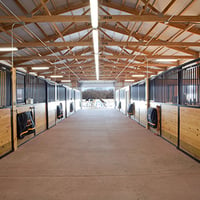 According to equestrian enthusiasts, an ideal stall size is 12’ x 12’. Of course, if you own miniature horses or ponies, you can get by with a smaller pen.
According to equestrian enthusiasts, an ideal stall size is 12’ x 12’. Of course, if you own miniature horses or ponies, you can get by with a smaller pen.
Nevertheless, a horse should always have enough room to get up, turn around, and lie down comfortably.
As for aisles, please give thought to your mobility needs. Ask yourself the following questions:
- Do you have adequate space to move your animals from stall to stall or another area?
- Is there room for you to saddle up your horse?
- Can you drive a utility tractor or vehicle through the barn to unload feed or haul bedding?
We suggest 12’ and above for aisle length. Anything less will leave your horse barn feeling and looking constrained.
Altogether, cramped horse stalls and aisles are inefficient and hinder your building flow.
3) Add a Wash Bay for Your Horses
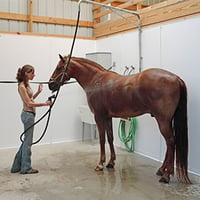
Like humans, horses need a shower too. Instead of tying them to the nearest tree, we recommend installing a well-designed wash bay.
The best part is that you can rinse your horses off any time of the year with a designated space inside.
As you map out a wash area, please consider the following factors:
Location
A wash rack should be convenient to use. Since water is involved, you’ll want to make sure that it’s situated far away from tack and feed areas, as well as riding arenas. Trust us; you don’t want wet leather, feed, or riders.
If possible, we suggest placing wash racks near the laundry and restroom facilities. You’ll save money with water and sewer lines already there.
Flooring Options
Although it’s costly, a concrete slab will provide a durable surface for washing horses. Score the top layer with a broom or rake to eliminate any slips.
Gravel may drain well, but most horses don’t like to stand on uneven flooring for long periods.
Drainage & Runoff
Drainage should be at the top of your list if you want to build a useful wash bay. Water runs downhill; therefore, you should locate your wash rack at a high point within your horse barn.
Next, you should make sure the concrete slab is even. Install a drain for wastewater to exit. Avoid clogs by keeping this area free of hair and manure (as much as possible). Runoff should be water only.
Water & Electricity
Water and electricity are a deadly combination. For you and your horses’ safety, please make sure that a licensed electrician installs all wiring.
Avoid electrical outlets near the wash stalls. If you install a water heater, you’ll need to store it in a waterproof cupboard.
When in doubt, always check with an experienced contractor or electrician for proper installation techniques. It’s better to be safe than sorry.
Stall Size
We’ve said it once, and we’ll say it again: horse stall size matters.
Small wash bays are not only inconvenient but dangerous for groomers. Not all horses will cooperate. The last thing you’d want is to be in a tight space with an unruly animal.
As a result, we recommend 12’ x 12’ wash bays with built-in rails. This stall size is enough room for a horse to walk in and turn around, while the groomer easily (and safely) cleans those hard-to-reach areas. It’s a win-win situation.
4) Install an Air Ventilation System
Sufficient airflow is crucial for your animals’ health. Every equine facility should have a ventilation system installed.
When the manure produces moisture, how will it exit the structure? Below, we detail four ways to ventilate your horse barn.

Overhangs
Air moves upward as it warms and rises. Having 1’ or 2’ overhangs with vented soffits on the side of your building will draw air inside.
At the peak of the roof, ridge vents work to release the warm, humid air.
If your building design doesn’t include overhangs, you can always install an eave vent to regulate airflow.
An eave vent is a vent mounted under the eave of your pole barn that lets air enter via the roof space. Again, the air will exit through the ridge vent.
Cupolas
Often added for aesthetic purposes, cupolas can help with ventilation. If installed to be functional, cupola fans require electricity.
Adding a cupola to your post frame building will allow a way for trapped heat to escape through the fan and side vents.
For a personalized touch, you can top it off with a weathervane.
Doors & Windows
It seems evident, but doors and windows are standard building features that encourage air movement.
Typically, the wind blows in a west to east direction. The placement of this ventilation system depends on your building’s location and use.
Whichever way the wind blows will determine the doors and windows you’ll want to open for the best ventilation.
In addition, we suggest evenly distributed doors and windows for better results.
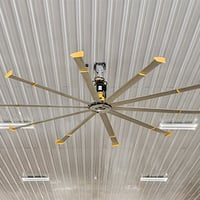
Mechanical Ventilation
Opposite of natural ventilation, mechanical ventilation controls the air movement by using one or more fans.
It isn’t commonly used for post frame buildings because it increases initial operating and maintenance costs.
Mechanical ventilation is used when natural ventilation isn’t enough. In this case, you’ll want to consider installing the following interior items:
-
- Ceiling fans
- Portable fans
- Larger, installed fan units
- Combination of any listed above
Are you looking for a reliable fan manufacturer? Our customers love their Global Industrial and Big Ass Fans (yes, that really is their brand name) products.
However, we recommend passive ventilation compared to active from a cost-effective perspective.
Each of these four options will work to improve the indoor air quality for you and your horses.
5) Include a Tack Room
Every great equine facility includes a tack room.
It’s a place to store blankets, bridles, brushes, saddles, and other related equipment.
Usually, tack rooms are closed off from different parts of the horse stable to keep dust out.
6) Utilize Natural Lighting Sources
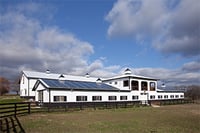 Energy efficiency is another critical aspect of any pole barn project.
Energy efficiency is another critical aspect of any pole barn project.
To lower your energy bill, we recommend relying on multiple windows for natural light. Install doors (e.g., overhead or walk-in) with window panes to provide ample light.
As stated above, doors and windows are a useful ventilation feature. Not to mention, energy-efficient choices can help low your building’s heating and cooling costs.
We don’t know about you, but we’re all for saving money wherever we can.
7) Store Your Hay Elsewhere
We’ve all heard of a pole barn catching on fire due to excessive moisture build-up in hay or straw.
How does this happen? Moisture-ridden haystacks and bales can catch on fire because of a chemical reaction that produces heat.
Hay acts as an insulator. The larger the stack, the less cooling that occurs to counteract the heat.
No farmer, rancher, or stable owner wants to see his/her building and equipment engulfed in flames. Then, you add livestock to the mix. It’s an unfortunate and devastating occurrence.
With that being said, we suggest storing your hay or straw away from the horse barn.
8) Never Say Never to Extra Amenities
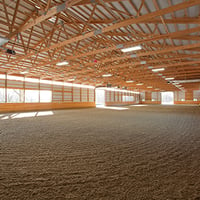 Perhaps, the best part of post frame construction is its versatile nature. Your floor plan includes the basic necessities: stalls, wash bays, and a tack room.
Perhaps, the best part of post frame construction is its versatile nature. Your floor plan includes the basic necessities: stalls, wash bays, and a tack room.
Now, it’s time to splurge on extra amenities that you’ll appreciate.
Add living quarters equipped with a kitchen, laundry room, and restroom. Don’t forget to include comfy furnishings (e.g., couch and TV) to enjoy after a long day at work. It’s your home away from home!
Take your equine facility to the next level with a well-sized indoor riding arena – no need to haul your horses somewhere else for a ride.
There are plenty of flexible horse barn designs that you and your animals can both enjoy. Don’t have room in the budget for these upgrades? No worries, you can always add-on to your post frame building.
Are You Ready to Design Your Horse Barn?
Ultimately, how you design your post frame building is up to you. Our goal as one of the top post frame builders in the Midwest is to provide tips that will help you build your dream horse barn.
Are you interested in seeing floor plans? Download our FREE Horse Barn Plan Book. This detailed guide includes 20 different layouts, including stables and stall barns, riding arenas, and multi-purpose buildings.
If a floor plan catches your eye, but you’d like to make a few minor tweaks, please let us know. All of our post frame structures are customizable. No cookie-cutter floor plans here. Our equine facilities are built around your needs.
Also, you can design your pole barn with our online 3D Design Tool. Save, print, or email your floor plan to family and friends.
Are you ready for a quote? Submit your design to us, and a member of our sales team will give you a call to begin the estimating process.
Additional Resources:
If you're looking for more resources on building a horse barn or horse barn designs, we also recommend that you take a look at the Top 100 Equestrian Blogs.
You can subscribe to these websites because they are actively working to educate, inspire, and empower their readers with frequent updates and high-quality information.
Have more questions about horse barns not covered in this article? Please contact FBi Buildings at 1.800.552.2981 or click here to email us. If you are ready to get a price, click here to request a quote and a member of our sales team will call you.
